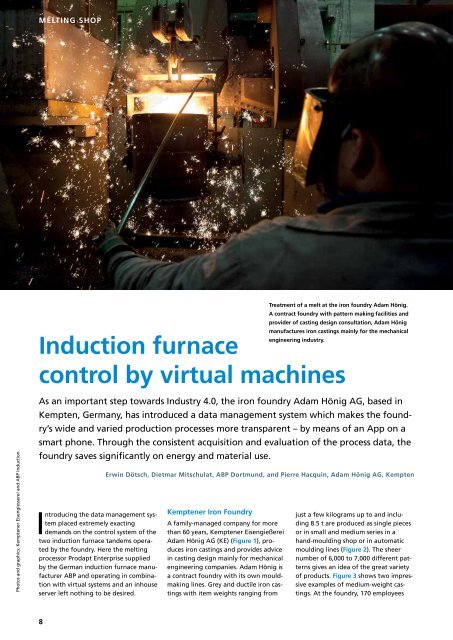CPT International 4/2019
You also want an ePaper? Increase the reach of your titles
YUMPU automatically turns print PDFs into web optimized ePapers that Google loves.
MELTING SHOP<br />
Photos and graphics: Kemptener Eisengiesserei and ABP Induction<br />
engineering industry.<br />
Induction furnace<br />
control by virtual machines<br />
As an important step towards Industry 4.0, the iron foundry Adam Hönig AG, based in<br />
Kempten, Germany, has introduced a data management system which makes the foundry’s<br />
wide and varied production processes more transparent – by means of an App on a<br />
smart phone. Through the consistent acquisition and evaluation of the process data, the<br />
foundry saves significantly on energy and material use.<br />
Introducing the data management system<br />
placed extremely exacting<br />
demands on the control system of the<br />
two induction furnace tandems operated<br />
by the foundry. Here the melting<br />
processor Prodapt Enterprise supplied<br />
by the German induction furnace manufacturer<br />
ABP and operating in combination<br />
with virtual systems and an inhouse<br />
server left nothing to be desired.<br />
Erwin Dötsch, Dietmar Mitschulat, ABP Dortmund, and Pierre Hacquin, Adam Hönig AG, Kempten<br />
Kemptener Iron Foundry<br />
A family-managed company for more<br />
than 60 years, Kemptener Eisengießerei<br />
Adam Hönig AG (KE) (Figure 1), produces<br />
iron castings and provides advice<br />
in casting design mainly for mechanical<br />
engineering companies. Adam Hönig is<br />
a contract foundry with its own mouldmaking<br />
lines. Grey and ductile iron castings<br />
with item weights ranging from<br />
Treatment of a melt at the iron foundry Adam Hönig.<br />
A contract foundry with pattern making facilities and<br />
provider of casting design consultation, Adam Hönig<br />
manufactures iron castings mainly for the mechanical<br />
just a few kilograms up to and including<br />
8.5 t are produced as single pieces<br />
or in small and medium series in a<br />
hand-moulding shop or in automatic<br />
moulding lines (Figure 2). The sheer<br />
number of 6,000 to 7,000 different patterns<br />
gives an idea of the great variety<br />
of products. Figure 3 shows two impressive<br />
examples of medium-weight castings.<br />
At the foundry, 170 employees<br />
8

















